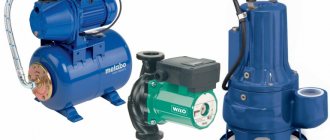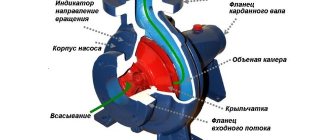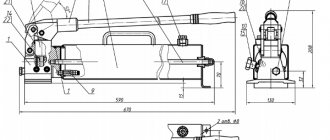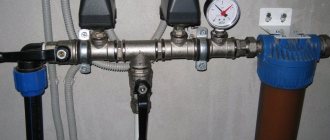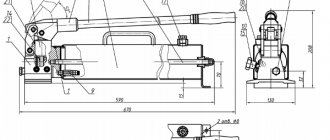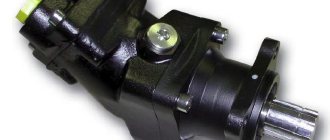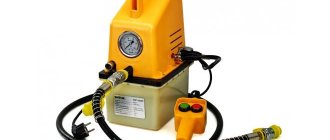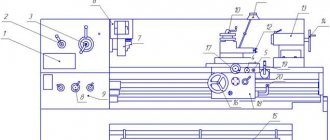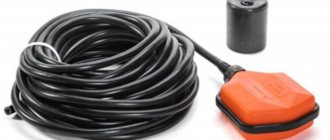Operating principle of a jet pump
A jet pump is a simple device that imparts movement to the flow of water.
This type of unit is used as a supercharger. The structure does not contain parts that move or come into contact during operation. This makes the pump highly stable and has a long service life.
This pump appeared in the 19th century as a laboratory tool to pump out excess water and air from flasks. Then the device began to be used in the mining industry to pump water out of mines.
Advantages and disadvantages of jet units
Among the main advantages of such units are a simple and reliable design, durability in operation, reliability and lack of sensitivity to aggressive environments. To a large extent, these advantages are due to the fact that jet pumps are free of moving parts, which in other pumps quickly wear out. By the way, this same design feature allows pumps to be manufactured in small sizes, which also affects the minimization of maintenance costs. But there are also disadvantages to such devices, including the need for special preparation of working fluids and low performance indicators.
Scheme of operation of the inkjet device
Figure 2 – Schematic diagram of the functioning of a jet pump
1- pipeline for supplying working fluid; 2 – pump nozzle; 3 – pipeline for supplying the injected liquid (the space around the nozzle is called the supply chamber or receiving chamber); 4 – flow mixing chamber; 5 – output diffuser.
The main one that describes the technical side of a jet pump device is the “ejection” coefficient (in different sources this same coefficient is called “suction”). This coefficient is determined by the ratio of the supply of the working volume of liquid to the volume of the pumped mixed flow.
Pumps of this type have a relatively low efficiency, but in some cases they are simply invaluable. For example, pumping chemical gases or liquids, where the use of centrifugal blade pumps is simply impossible (the jet dispenser pump shown in Figure 3).
Figure 3 – Jet pump dispenser for chemicals
Very often, the schematic diagrams for switching on jet pumps are arranged in a series connection of several units. In this case, pumps are designed with different nozzle diameters, which makes it possible to adjust the discharge flow characteristics within the operating range of units connected in series.
Shaft and bearings
Whatever type of wheel is used, it is mounted on a rotating shaft. The shaft must be secured in the housing with bearings in one of 2 ways:
- Console
- Symmetrical
Cantilever fastening
When the shaft is cantilevered, the impeller is fixed at one end and the bearings at the other.
This design places the suction and discharge ports perpendicular to each other, and the suction port directly in front of the center of the wheel.
Such pumps are called end suction pumps. They are widely used because they are cheap and easy to produce, but they have one drawback related to the path of fluid movement.
During pump operation, a low pressure zone is created in the suction port.
There is a high-pressure zone at the outlet of the wheel, from which the energized fluid enters the spiral casing.
Fluid flows towards the rear plate in open and semi-open wheels, which completely destroys the pressure balance. As a result, an axial force or load occurs - pushing the wheel towards the suction hole.
This can be compensated for by installing stronger bearings or drilling holes in the wheel plate to equalize the pressures. But these are not effective methods.
Symmetrical mounting
A more effective solution is to place the shaft on bearings on both sides. This is called symmetrical design.
Shaft support is improved not only by the placement of bearings on both sides, but also by the ability to use symmetrical closed wheels with double suction.
Since there are the same high and low pressure zones on both sides of the wheel, this successfully eliminates loading forces due to the balance of pressures. This design also has another advantage. The suction and discharge ports are located parallel to each other on opposite sides of the pump, and the housing is axially divided.
By simply unscrewing the bolts and removing the cover, the service technician can access the rotating part of the pump inside without removing the entire pump from the system.
Due to the separate axial design, pumps with a symmetrical bearing arrangement are called split-casing pumps.
All of these, of course, are very good reasons to install such a pump in your mine right now. But there are some disadvantages. Because maintenance operations and sealing requirements are more complex for split casing pumps than for end suction pumps. They are also more expensive.
Operating principle of the jet pump: technical characteristics
Operating principle of a jet pump
A jet pump is a simple device that imparts movement to the flow of water.
This type of unit is used as a supercharger. The structure does not contain parts that move or come into contact during operation. This makes the pump highly stable and has a long service life.
This pump appeared in the 19th century as a laboratory tool to pump out excess water and air from flasks. Then the device began to be used in the mining industry to pump water out of mines.
What types of water jet installations are there?
The equipment is designed in many configurations and modifications. Water jet pumps are made from various materials:
- Glass;
- Metal;
- Plastic.
Plastic and metal vacuum systems are not only more reliable and durable, but also more durable. They are equipped with a variety of additional equipment: a union nut with a reliable gasket for a high-quality connection with the main water tap, a shut-off valve, a single safety valve, and a pressure gauge.
The advantages of water jet units are their ease of use, as well as the ability to pump out water and sand. They are insensitive to its quality. The vacuum pump has one serious drawback - high water consumption with a low efficiency.
The hydraulic elevator is included in the kit of each fire truck. It is used to collect water from water sources. Especially those that are difficult to access by car, or swampy banks of rivers and lakes. The fire hydraulic elevator is an ejector type pump. In such devices, water flows through a hose attached to the head at the elbow, and then into the nozzle.
German-made jet pumps have proven themselves well on the market.
Artesian pumping systems are:
- Deep, they are suspended from the well;
- Electric submersible, which are connected to an electric motor and installed in a well below the water level.
Jet pumps are practically not used in traditional water supply and irrigation systems. They have found their application under conditions of increased loads. They handle chemicals and contaminated environments very well while maintaining original performance characteristics. They have the advantages of being easy to use and not requiring a compressor.
All of the above devices are used both industrial and household. In many areas of human activity, such devices are necessary and very important; they cope with many tasks in which other technology is powerless.
How does a jet pump work, its operation diagram
A jet pump is the simplest device that uses the dynamics of fluid flow to operate. It is one of the types of superchargers. Simple, because in its design it does not have components that move and rub during operation. Therefore, a device of this type has high durability and long service life.
The jet pump was first used in the 19th century as a laboratory means for pumping water and excess air from test tube flasks. A little later, this device found application in mines for pumping water.
Figure 1 – Jet pump
At the current stage of development of pumping equipment, jet pumps, there are several modifications:
- elevators – used in in-house mixing heating systems
- injectors – used in power heating equipment;
- ejectors – only for media in the liquid phase.
General information
Features of the unit
Jet pumping devices help move substances in different states of aggregation through pipes equipped with a nozzle having a narrowed structure. As the device narrows, the flow rate increases. The energy with which the fluid moves is converted into kinetic energy.
This type of equipment is not a standard injection device, since it does not provide strong pressure in the area of injection-type pipe rolling. In the pumping apparatus, a double energy conversion of the flow occurs.
Device Basics
A liquid medium moves towards the tapering nozzle under the influence of pressure. The flow emanating from the nozzle makes the pressure in the mixing compartment lower than in the atmosphere. Another stream, the medium being processed, is mixed with the liquid, and it flows into the working compartment.
When the working type of liquid is mixed with the injected one, the pressure values with the flow rate are equalized. The thoroughly mixed media flow into the outlet diffuser. In it, the kinetic energy of the medium decreases and the potential energy increases. At the outlet of the diffuser, the volume of potential energy becomes such that it can flow to a consumption unit, for example, into a container where liquid is collected.
Details
Diagram of how jet pumps work
The pump consists of certain structural parts that do not rotate. All elements are aimed at ensuring mixing of the working fluid with the injected fluid. These include:
1.pipeline through which water is delivered.
2.pump nozzle.
3.pipe to supply the injected liquid.
4.chamber where the flows are mixed.
5.output diffuser.
The technical characteristics of jet pumps are based on the ejection coefficient, otherwise known as “suction”. The value of the coefficient is found based on the ratio of the volume of working fluid and the volume of moving mixed fluid.
These pumps have a low efficiency, but in some situations it is impossible to do without them. They must be installed when transporting chemical gases or liquids, when it is impossible to use centrifugal blade blowers.
Sometimes a circuit contains several devices connected in series. In this situation, pumping units have different nozzle sizes in order to regulate the pressure and speed of fluid movement in the operating mode of all devices turned on.
Buy a fecal pump at “All Tools”
Attention! Nozzle attachments in pumps can have different characteristics, this depends on the type of liquid being pumped and its properties.
Pros and cons of pumps
Jet-type pumping devices have positive and negative properties. Positive characteristics include:
1.high reliability, wear resistance, long service life.
2.does not require constant maintenance activities.
3.have slight sensitivity to aggressive environments.
4.have a simple design, easy installation.
5.used in various fields.
Pumps have advantages over other devices because they do not contain moving parts. These units have small dimensions and optimal weight. They are not expensive to operate, which makes their use more attractive.
Negative characteristics include:
1. low equipment efficiency, not exceeding thirty percent.
2. It is required to supply a large amount of transported medium to the nozzle.
Attention! Using jet units, it is possible to compress a gaseous medium, create a pressure less than in the atmosphere, that is, create a vacuum, transport liquids, bulk solids, mix gases with liquids.
Scope of application of the jet unit
Although the efficiency of pumps of this type is not high, in some cases such mechanisms are used quite widely and often due to the principle of their operation. The main use of units of this type is noted in the following industries:
- Food industry;
- Fire extinguishing or sewage systems;
- Air conditioning and ventilation systems;
- Heat and gas supply communications;
- In combination with vane (centrifugal) pumps to increase overall efficiency;
- As an auxiliary equipment for air intake from the working chamber of a centrifugal pump and its water inlet pipe.
Application range of pumps
These pumps are widely used in the fire industry, as mixers in technology, to produce foam that is used to extinguish fires. Jet devices are used to operate steam turbine units in the energy sector. They remove steam from the sealing areas of turbine shafts. In the chemical industry, acids and alkalis are pumped using pumps. In everyday life, a jet pump can be used in the construction of water wells and in the construction of sewers through which wastewater containing sand and silt moves.
Buy a fecal pump at “All Tools”
Types and classification of pumps
A pump is a type of hydraulic machine that moves fluid by suction and discharge using kinetic or potential energy. The pump is necessary for use in fire-fighting equipment, for draining liquids in residential areas, for supplying fuel and many other purposes. There are different types and types of pumps depending on the area of application, design, and principle of operation. When using pumps for various purposes, you need to know what types there are and how they differ.
Pumps for fire extinguishing systems
The main requirement for fire extinguishing system pumps is the supply of water under high pressure. Centrifugal pumps are the most commonly used because they allow water to be pumped quickly using centrifugal force. Important points when choosing a fire extinguishing pump are:
- pressure;
- wheel speed;
- efficiency;
- suction lift;
- volume of water moved.
Depending on the number of wheels with blades, pumps are single-stage or multi-stage. Multistage units allow you to create higher pressure, which in turn affects the pressure and height of the supplied liquid.
When installing fire extinguishing systems in buildings, it is worth considering that the equipment must be checked periodically, since stagnation can cause difficulties during startup. Fire trucks are equipped with centrifugal pumps and auxiliary units.
Auxiliary pumps fill the centrifugal pump housing with liquid and turn off automatically.
Oil and fuel pumps
Industrial types of pumps include oil and fuel devices installed on automobile and machine engines and internal combustion engines.
Oil pumps reduce friction between interacting engine parts. They are adjustable and unregulated. Car engines are equipped with rotary or gear pumps for pumping oil.
Fuel pumps are installed in cars without fail. They ensure the delivery of fuel from the tank to the combustion chamber. Depending on the design, fuel pumps are either mechanical or electric.
Submersible pumps
Submersible pumps are used when working at a depth of more than eight meters. All types of submersible pumps have a cooling system and are also made of durable material that helps avoid deformation under pressure. Submersible pumps are either centrifugal or vibration pumps. In the second type of pumps, liquid is sucked in using a vibration or electromagnetic mechanism.
When choosing a pump, it is important to consider a large number of factors:
- purpose of use;
- place of use;
- the need to install auxiliary units;
- pump dimensions;
- pump operation method.
(5 5.00 out of 5) Loading…
Jet pump device
As already mentioned, the jet pump does not contain any rotating parts in its design. All elements and components of the pump are designed to ensure the operation of the working and injected flows.
Structurally, the jet pump consists of 4 elements:
- suction chamber;
- unit nozzle;
- mixing chamber;
- output diffuser;
- nozzles for supplying injected and working fluids.
Various models of this type of pump can be equipped with tapering nozzles of different characteristics, depending on the type of pumped medium and its hydraulic features.
IPC / Tags
Jet Vacuum Pump
Patent number: 1479711
. at the State Committee for Science and Technology of the USSR113035, Moscow, Zh, Raushskaya embankment, 4/5 Production and publishing plant "Patent", Uzhgorod, st. Gagarina, 03 The invention relates to vacuum technology and can be used in jet vacuum pumps. The purpose of the invention is to reduce the time it takes to reach the operating mode and reduce the reverse flow of working fluid vapors. The drawing shows a steam jet vacuum pump, a longitudinal section. The jet vacuum pump contains a housing 1, steam lines 2 with nozzles 3, a boiler 4, a heater 5 and bases 6 of steam lines 2 placed in it, and the pump is equipped with valves 7 of a conical yorma installed in the bases 6 of steam lines 2 in a normally closed position. The pump operates as follows. The pump being poured into the boiler 4 is working.
Jet adjustable pump
Patent number: 543780
. range of regulation of the flow of the working medium. This is achieved by the fact that a removable nozzle is installed in the hole of the rod, and to prevent water hammer when replacing the removable nozzle, a slot is made at the end of the rod located in the pump cavity to align it with the nozzle when the rod is extended outward. In Fig. 1 shows the proposed pump, general view; in fig. 2 - nozzle, rod with a hole and a removable nozzle, transverse 543780f Formula of the invention in which a rod 7 movable in the radial direction is installed, one end of which is brought out through the seal 8, and the other is placed in the cavity of the pump and has a hole 9, installed coaxially with the nozzle 4 using a lock 10 In hole 9 of rod 7 there is a removable nozzle 11, Between.
Performance characteristics
Typically, such units, which use fluids that are gentle from the point of view of structural wear, do not have high performance indicators. The example of jet pumps partly confirms this, but in some application segments its capabilities are quite sufficient. For example, the productivity of the devices can reach 30 l/s. This indicator refers to professional equipment, and simplified designs provide an average of 15-17 l/s. As for the lift height, the operation of the jet pump is designed for a range of 8-15 m, although some modifications for specialized purposes can provide a 20-meter lift. But in this case, productivity and efficiency are noticeably reduced, so alternative pump designs are often used for such needs.
